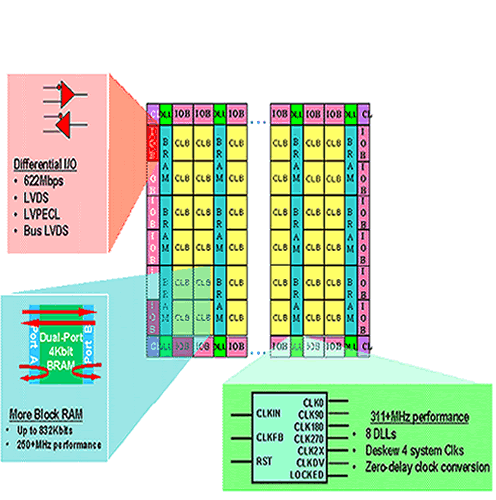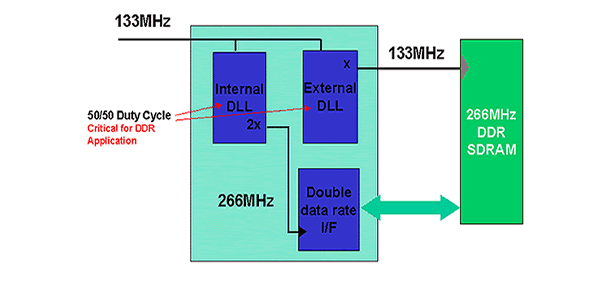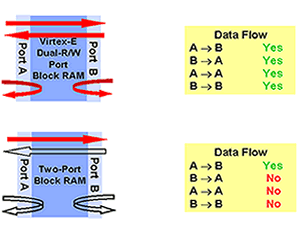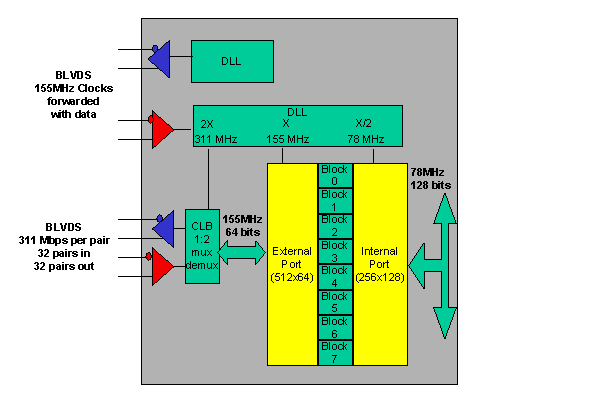|
Virtex-E Aggregate Bandwidth Summary
High-Performance Differential Signaling: LVPECL, LVDS,
and Bus LVDS
Typical aggregate bandwidth requirements for leading edge systems are
exceeding 100 Gbps. Increasingly, leading systems designers are turning
to differential signaling as the mechanism of choice for these requirements.
Differential signaling enables high bandwidth while reducing power, increasing
noise immunity, and decreasing EMI emissions. Virtex-E devices meet this
emerging challenge with unprecedented capabilities and support for high-performance
differential signaling. Virtex-E SelectI/O+ technology addresses the three
leading industry-standard differential signaling standards: LVPECL, LVDS,
and Bus LVDS (BLVDS).
LVPECL I/O is widely used in 100+ MHz inter-chip signaling in high-speed
data communications and instrumentation systems. Fiber-Optic Network Interfaces
and gigahertz Analog-to-Digital Converters, for example, rely on LVPECL
I/O to achieve gigabit per second bandwidth. All Virtex-E I/Os support
LVPECL input, output, and I/O signaling. This unparalleled flexibility
enables users to create interfaces to hundreds of industry-standard LVPECL
devices.
In addition to high-speed interfacing, LVPECL is the industry standard
for transmission of precise, on-board clocks at frequencies in excess of
100 MHz. While traditional LVTTL clock sources are typically limited to
100 MHz and below (due to the fundamental signal integrity limits), LVPECL
clock sources provide operation up to 400 MHz. As FPGA system clock frequencies
exceed 100 MHz, LVPECL clocking becomes an essential requirement. The Virtex-E
device supports high-performance LVPECL clock inputs for global and local
clocking, with frequencies in excess of 300 MHz. In addition, through the
use of its multiple DLLs coupled with SelectI/O+ technology, the Virtex-E
devices enable zero-delay conversion of precise LVPECL clocks into virtually
any required I/O standard. This facilitates the use of Virtex-E FPGAs as
an integral part of high-performance board-level clock distribution strategies.
In addition to LVPECL, the Virtex-E family has the industry’s first
programmable devices to support Low-Voltage Differential Signaling (LVDS).
LVDS exists in two commonly available variants, LVDS and Bus LVDS. LVDS
is optimized for high-speed point-to-point links, while Bus LVDS is optimized
for backplane applications employing Multi-Drop (One Transmitter, Multiple
Receiver), and MultiPoint (Multiple Transmitters and Receivers) configurations.
The Virtex-E device provides unparalleled support for both LVDS and Bus
LVDS, with support on all devices and speed grades, and up to 688 pins
(344 pairs) of LVDS and/or Bus LVDS capabilities on the largest device,
providing an aggregate bandwidth in excess of 100 Gbps. The Virtex-E Bus
LVDS I/Os are fully compatible with industry-standard Bus LVDS devices
from National Semiconductor and other vendors.
True Dual-Port Embedded Block Memory for Highest Internal Memory
Bandwidth
Whether used as FIFOs to buffer data on and off chip, caches for high
speed parallel searches, or ATM packet buffers, the system requirements
for more memory grows much faster than it does for the requirement for
more logic. Xilinx pioneered using embedded distributed memory (with its
SelectRAMÔ technology) in its XC4000 FPGAs
to allow the configurable logic block to support logic or memory. With
the Virtex series, this technology was enhanced to include up to 128 Kbits
of True Dual-Port fast-embedded block RAM. The Virtex-E family again provides
a quantum leap in internal memory bandwidth by supporting up to 832 Kbits
of True Dual-Port
RAM (208 blocks of 4Kbits memory) capable of 250 MHz performance. |



